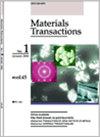紫外光照射下ZnO-ZnCr<sub>2</sub> o>4</sub>/g-C<sub>3</sub>N<sub>4</sub>尿素燃烧法制备纳米复合材料
IF 1.9
4区 材料科学
Q4 MATERIALS SCIENCE, MULTIDISCIPLINARY
引用次数: 0
摘要
由于各国的快速发展,有机染料已被应用于皮革、纺织品、纸张、化妆品等制造产品。然而,这些工业产生的废水对环境和生物都是有害的。此外,有机染料含有有毒的致癌物质,并导致水中氧含量降低,这对自然和人们使用的水资源有害。光降解是一种低成本、高效率、低能耗的去除这些物质的方法。本研究采用锌基材料作为降解催化剂。采用尿素燃烧法制备了ZnO-ZnCr2O4 /g-C3N4纳米复合材料,并将其作为紫外光下罗丹明B (RhB)降解的光催化剂。采用XRD、FESEM、BET、UV-Vis、TEM等手段对ZnO-ZnCr2O4 /g-C3N4进行了表征。不同退火温度下ZnO-ZnCr2O4 /g- c3n4纳米复合材料的比表面积在36.33 ~ 107.55 m2/g之间变化。此外,通过紫外光照射12小时,考察了ZnO-ZnCr2O4 /g-C3N4纳米晶体对RhB的光催化活性。12 h后,在紫外光照射下,95.45%的RhB被降解。循环实验结果表明,500℃退火ZnO-ZnCr2O4 /g-C3N4纳米复合材料的速率常数最高,达到6.11 × 10−3 min−1,具有良好的稳定性。本文章由计算机程序翻译,如有差异,请以英文原文为准。
Photodegradation under Ultraviolet Light Irradiation of RhB by ZnO–ZnCr<sub>2</sub>O<sub>4</sub>/g-C<sub>3</sub>N<sub>4</sub> Nanocomposites Fabricated by Urea Combustion Method
Due to the rapid national development of various countries, organic dyes have been applied in manufacturing products such as leather, textiles, paper, and cosmetics. However, the wastewater produced by these industries is harmful to the environment and organisms. Moreover, organic dyes contain toxic carcinogens and cause the reduction of the oxygen content in water, which is harmful to nature and the water resources people use. Photodegradation is a low-cost, highly efficient, and low-energy way to remove these substances. Zinc-based materials were applied as a degradation catalyst in this study. ZnO–ZnCr2O4/g-C3N4 nanocomposites were fabricated by the urea combustion method and used as photocatalysts for rhodamine B (RhB) degradation under ultraviolet A (UVA) light irradiation. ZnO–ZnCr2O4/g-C3N4 was investigated by XRD, FESEM, BET, UV-Vis, and TEM to confirm the crystalline microstructure. Based on the various annealing temperatures of ZnO–ZnCr2O4/g-C3N4 nanocomposite, the specific surface area varied from 36.33 m2/g to 107.55 m2/g. In addition, the photocatalytic activities of ZnO–ZnCr2O4/g-C3N4 nanocrystals were investigated through the degradation of RhB under UV light for 12 hours. After 12 hours, 95.45% of the RhB was degraded under UV light irradiation. ZnO–ZnCr2O4/g-C3N4 nanocomposites annealed at 500°C exhibited the highest rate constant, up to 6.11 × 10−3 min−1, and ZnO–ZnCr2O4/g-C3N4 revealed excellent stability based on the results of the cyclic test.
求助全文
通过发布文献求助,成功后即可免费获取论文全文。
去求助
来源期刊

Materials Transactions
工程技术-材料科学:综合
CiteScore
2.00
自引率
25.00%
发文量
205
审稿时长
2.7 months
期刊介绍:
Information not localized
 求助内容:
求助内容: 应助结果提醒方式:
应助结果提醒方式:


